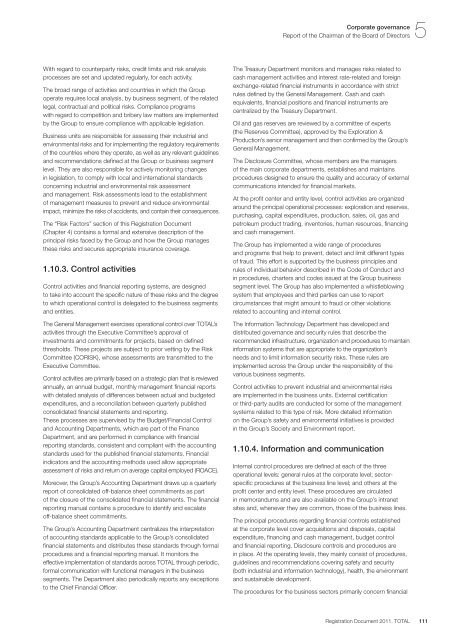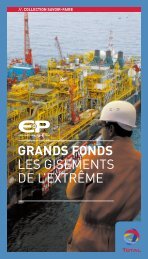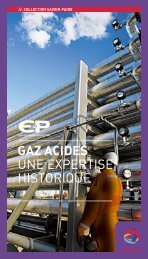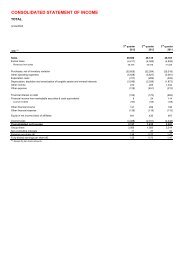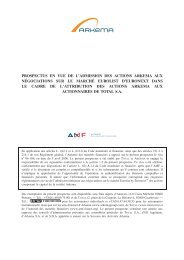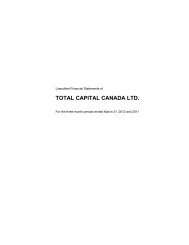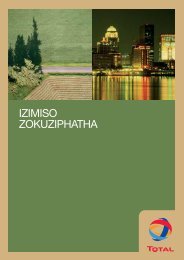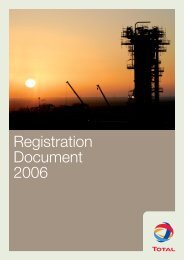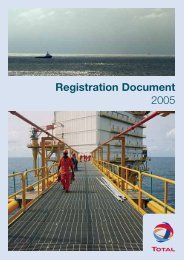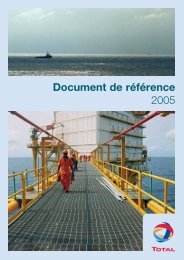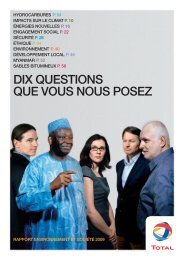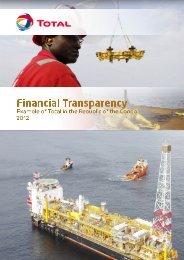Registration document 2011 - tota - Total.com
Registration document 2011 - tota - Total.com
Registration document 2011 - tota - Total.com
You also want an ePaper? Increase the reach of your titles
YUMPU automatically turns print PDFs into web optimized ePapers that Google loves.
With regard to counterparty risks, credit limits and risk analysis<br />
processes are set and updated regularly, for each activity.<br />
The broad range of activities and countries in which the Group<br />
operate requires local analysis, by business segment, of the related<br />
legal, contractual and political risks. Compliance programs<br />
with regard to <strong>com</strong>petition and bribery law matters are implemented<br />
by the Group to ensure <strong>com</strong>pliance with applicable legislation.<br />
Business units are responsible for assessing their industrial and<br />
environmental risks and for implementing the regulatory requirements<br />
of the countries where they operate, as well as any relevant guidelines<br />
and re<strong>com</strong>mendations defined at the Group or business segment<br />
level. They are also responsible for actively monitoring changes<br />
in legislation, to <strong>com</strong>ply with local and international standards<br />
concerning industrial and environmental risk assessment<br />
and management. Risk assessments lead to the establishment<br />
of management measures to prevent and reduce environmental<br />
impact, minimize the risks of accidents, and contain their consequences.<br />
The “Risk Factors” section of this <strong>Registration</strong> Document<br />
(Chapter 4) contains a formal and extensive description of the<br />
principal risks faced by the Group and how the Group manages<br />
these risks and secures appropriate insurance coverage.<br />
1.10.3. Control activities<br />
Control activities and financial reporting systems, are designed<br />
to take into account the specific nature of these risks and the degree<br />
to which operational control is delegated to the business segments<br />
and entities.<br />
The General Management exercises operational control over TOTAL’s<br />
activities through the Executive Committee’s approval of<br />
investments and <strong>com</strong>mitments for projects, based on defined<br />
thresholds. These projects are subject to prior vetting by the Risk<br />
Committee (CORISK), whose assessments are transmitted to the<br />
Executive Committee.<br />
Control activities are primarily based on a strategic plan that is reviewed<br />
annually, an annual budget, monthly management financial reports<br />
with detailed analysis of differences between actual and budgeted<br />
expenditures, and a reconciliation between quarterly published<br />
consolidated financial statements and reporting.<br />
These processes are supervised by the Budget/Financial Control<br />
and Accounting Departments, which are part of the Finance<br />
Department, and are performed in <strong>com</strong>pliance with financial<br />
reporting standards, consistent and <strong>com</strong>pliant with the accounting<br />
standards used for the published financial statements. Financial<br />
indicators and the accounting methods used allow appropriate<br />
assessment of risks and return on average capital employed (ROACE).<br />
Moreover, the Group’s Accounting Department draws up a quarterly<br />
report of consolidated off-balance sheet <strong>com</strong>mitments as part<br />
of the closure of the consolidated financial statements. The financial<br />
reporting manual contains a procedure to identify and escalate<br />
off-balance sheet <strong>com</strong>mitments.<br />
The Group’s Accounting Department centralizes the interpretation<br />
of accounting standards applicable to the Group’s consolidated<br />
financial statements and distributes these standards through formal<br />
procedures and a financial reporting manual. It monitors the<br />
effective implementation of standards across TOTAL through periodic,<br />
formal <strong>com</strong>munication with functional managers in the business<br />
segments. The Department also periodically reports any exceptions<br />
to the Chief Financial Officer.<br />
Corporate governance 5<br />
Report of the Chairman of the Board of Directors<br />
The Treasury Department monitors and manages risks related to<br />
cash management activities and interest rate-related and foreign<br />
exchange-related financial instruments in accordance with strict<br />
rules defined by the General Management. Cash and cash<br />
equivalents, financial positions and financial instruments are<br />
centralized by the Treasury Department.<br />
Oil and gas reserves are reviewed by a <strong>com</strong>mittee of experts<br />
(the Reserves Committee), approved by the Exploration &<br />
Production’s senior management and then confirmed by the Group’s<br />
General Management.<br />
The Disclosure Committee, whose members are the managers<br />
of the main corporate departments, establishes and maintains<br />
procedures designed to ensure the quality and accuracy of external<br />
<strong>com</strong>munications intended for financial markets.<br />
At the profit center and entity level, control activities are organized<br />
around the principal operational processes: exploration and reserves,<br />
purchasing, capital expenditures, production, sales, oil, gas and<br />
petroleum product trading, inventories, human resources, financing<br />
and cash management.<br />
The Group has implemented a wide range of procedures<br />
and programs that help to prevent, detect and limit different types<br />
of fraud. This effort is supported by the business principles and<br />
rules of individual behavior described in the Code of Conduct and<br />
in procedures, charters and codes issued at the Group business<br />
segment level. The Group has also implemented a whistleblowing<br />
system that employees and third parties can use to report<br />
circumstances that might amount to fraud or other violations<br />
related to accounting and internal control.<br />
The Information Technology Department has developed and<br />
distributed governance and security rules that describe the<br />
re<strong>com</strong>mended infrastructure, organization and procedures to maintain<br />
information systems that are appropriate to the organization’s<br />
needs and to limit information security risks. These rules are<br />
implemented across the Group under the responsibility of the<br />
various business segments.<br />
Control activities to prevent industrial and environmental risks<br />
are implemented in the business units. External certification<br />
or third-party audits are conducted for some of the management<br />
systems related to this type of risk. More detailed information<br />
on the Group’s safety and environmental initiatives is provided<br />
in the Group’s Society and Environment report.<br />
1.10.4. Information and <strong>com</strong>munication<br />
Internal control procedures are defined at each of the three<br />
operational levels: general rules at the corporate level; sectorspecific<br />
procedures at the business line level; and others at the<br />
profit center and entity level. These procedures are circulated<br />
in memorandums and are also available on the Group’s intranet<br />
sites and, whenever they are <strong>com</strong>mon, those of the business lines.<br />
The principal procedures regarding financial controls established<br />
at the corporate level cover acquisitions and disposals, capital<br />
expenditure, financing and cash management, budget control<br />
and financial reporting. Disclosure controls and procedures are<br />
in place. At the operating levels, they mainly consist of procedures,<br />
guidelines and re<strong>com</strong>mendations covering safety and security<br />
(both industrial and information technology), health, the environment<br />
and sustainable development.<br />
The procedures for the business sectors primarily concern financial<br />
<strong>Registration</strong> Document <strong>2011</strong>. TOTAL 111


